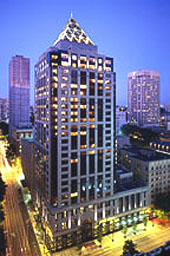|
Subscribe / Renew |
|
|
Contact Us |
|
| ► Subscribe to our Free Weekly Newsletter | |
| home | Welcome, sign in or click here to subscribe. | login |
Special Issues
| special issues index  February 24, 2000 | |||
|
Major changes may be in store on lodging front Dud of a millennium party hurt lodging market more than the WTO debacle
Despite what seems to be an ever-expanding base of hotels in the region, Seattle can be considered fortunate, if not downright lucky, not to have experienced the same kind of hotel supply increases in 1999 as Portland, San Francisco or Denver. Give credit to those developers and lenders who have refrained from grasping at the dwindling number of deals for available land and long-shot projects. Although unscathed in 1999, Seattle�s lodging landscape could experience major changes in the next five years. Given the new additions in the area, the region�s occupancy and average daily rates continued to perform fairly well compared to the rest of the nation. For year-end 1999, most of the sub-markets of the region experienced slightly lower occupancies compared to 1998. Even with the decrease, however, occupancy in downtown Seattle was still strong at over 77 percent for the year. Average room rates in most sub-markets grew, although not nearly as aggressively as during the past few years. Downtown and Seattle markets achieved room rate growth similar to the rate of inflation, while some markets did experience slight declines. Similar to national trends, Seattle and surrounding cities have seen the hotel industry divide and segregate into numerous factions, thereby creating the illusion of niche marketing. Throughout 1998 and again in 1999, the industry tried to recreate itself in limited-service, all-suite, extended-stay, economy extended-stay, budget-suites, and so on. Today, the trend seems to be shifting back to traditional lodging development with lenders running from niche development back to full-service, luxury and resort projects. Looking at individual markets, the South End continues to be the obvious winner (or loser) when it comes to new hotel supply. There have been numerous new developments and additions in the Tukwila, Kent and Federal Way areas, with more proposed. The South End will more than likely struggle to absorb all these projects, and may have an impact on surrounding markets, such as Tacoma and SeaTac. Although neither Tacoma nor SeaTac has seen any large hotel developments in recent years, projects continue to be discussed and expectations are that both will have additional full-service hotels in the near future. All of the new development in the South End has caused occupancies to fall closer to 70 percent, with average rates down a few dollars when compared to 1998. The market north of Seattle has seen one of the largest percentage increases in supply, with a significant number of projects developed along the Interstate 5 corridor, and through the Technology Corridor. The North End occupancy dropped to just over 50 percent, with average room rates dropping to nearly $70. The North End should continue to be a challenge going forward. Lake Union and downtown Seattle experienced lodging development in 1999 as well, albeit with less enthusiasm than the markets to the south and north. New development around Lake Union has mainly been niche development, such as limited-service without food and beverage and all-suite hotels. Although the niche development in the secondary and tertiary markets will have some impact on the Seattle market, it should not create such a ripple as to stop additional downtown lodging development. In 1999, downtown Seattle saw the addition of the W Hotel, and other additions to supply are expected. The Elliott Hotel is being constructed as part of the expansion of the Washington State Convention & Trade Center, and a new Hyatt project at Rainier Square is in the permit process. Other names associated with proposed downtown projects include Intercontinental, Ritz Carlton and Marriott. Downtown still has not seen the glut of new hotels similar to Portland or Denver, and with these proposed additions staggered in the development cycle, it is likely Seattle will absorb these projects with little impact. Adding to the excitement is the location of many of these developments. Although the Hyatt and Elliott projects are still within sight of the commercial and retail cores, some of the new developments are taking place in more pioneering areas, such as the waterfront and the Belltown neighborhood. As Belltown and the waterfront continue to heat up with new retail, restaurant and entertainment venues, hotels are expected to follow. Again, similar to national trends, the mega-hotels of years past have given way to scaled-down versions, with Seattle projects ranging in size from 150-450 rooms. These projects are undeniably easier to finance, build, and ultimately, fill.
Going forward, the Northwest, and more directly Seattle, continues to have issues with events that took place in the later half of 1999. Although the World Trade Organization rioting looked menacing as it was portrayed for a worldwide audience, actual impact on local hotel occupancies is yet to be determined. Greater initial impact seems to have occurred from the millennium excitement, or lack thereof. While Seattle struggled with decisions over millennium fanfare, reservation cancellations poured in. With that said, occupancy continues to be strong regionally and is expected to remain that way for the foreseeable future. As with all types of commercial development, hotel projects will continue to move forward as long as the economy remains stable and lenders aren�t scared off by local or national influences. In the near term, a strong regional economy, diversification of local industry and a growing tourism base will all help Seattle continue to be well poised for future lodging development. Christopher Buredett is with The Chambers Group, Inc., a hospitality industry consulting firm in Seattle.
|

